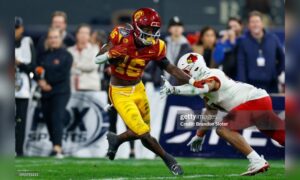One of the biggest questions the Pittsburgh Steelers are looking at on the offensive side of the ball is who their third wide receiver is going to be, working alongside Antonio Brown and Martavis Bryant, the latter of whom was immediately put into work with the first-team unit after returning from suspension.
While the Steelers spent the majority of their offensive snaps with three wide receivers on the field, they don’t use as many three-receiver sets as become the norm—at least that proved to be the case last season, which could be an aberration due to injuries and the late-season focus on running the ball.
But with that in mind, I think it would be a worthwhile service to look at the Steelers’ wide receiver group from last season relative to how they performed, specifically, when lining up in the slot in passing situations, because, generally speaking, the third wide receiver is probably going to spend the vast majority of time in that role.
Over the course of the next several days, I am going to review the application for each candidate for the job based on their 2016 performance there where applicable—which will not be the case for rookie JuJu Smith-Schuster for obvious reasons, while at the same time serving the purpose of talking about each player relative to their ability to play in the slot.
Candidate X: Miscellaneous
It’s time for the odds and ends portion of this series, in which I attempt to assemble a coherent narrative using incomplete or obsolete information about the Steelers’ past and future usage of the slot wide receiver in 2016 and 2017 (2016 is the past, 2017 is the future, for those playing along at home).
A quick housekeeping note, for posterity I have gone back to the original overview article for this study and included links to each individual study. This article is included for the entry in the data chart for Markus Wheaton.
Speaking of whom, the only wide receiver who logged a heavier dose of snaps out of the slot by percentage than Wheaton in 2016 was Eli Rogers. More than half of Wheaton’s passing snaps on which a pass was thrown saw him come out of the slot. This is a transition that he had to make, as he did not play that role in college.
Last year, he was only on the field for 67 pass attempts, and 35 of them saw him in the slot. He was targeted four times, yielding four receptions for a whopping 15 yards. He dropped one of those two incompletions.
Given that Wheaton is now with the Bears, however, the above data is not particularly relevant. And yet we lack comparably concrete data for the other relevant candidates here, those being Justin Hunter, the free agent most recently from Buffalo, and JuJu Smith-Schuster, the rookie second-round draft pick.
Of Smith-Schuster, at least we can say that he has already been given extensive work in the slot during OTAs, including some time spent with the first-team offense. While he is not necessarily ticketed for the slot, it seems likely that this is where they feel they will most likely be able to use him relative to the rest of the roster.
According to Pro Football Focus, Smith-Schuster ran 76 routes out of the slot in 2016 at USC, catching 15 of 19 targets for 147 yards and three touchdowns with one drop. His catch rate of nearly 79 percent was 26th out of 215 eligible college wide receivers out of the slot.
As for Justin Hunter, Alex Kozora noted in his scouting report after he signed with the Steelers that he did line up both inside and out of the slot. While he only caught 10 passes on the season, four made it into the end zone, and one of those was a 30-yard reception aligned from out of the slot.
You have to wonder about his long-term viability here, though. He can certainly be a seam-stretcher from the slot and provide mismatch options, due to his size and speed, but he lacks short-area quickness and decisiveness in his movement that will be disadvantageous for a position that spends so much of its time over the middle of the field and within 10 yards of the line of scrimmage.








